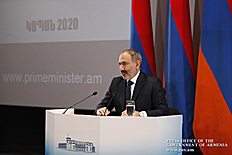 1670x1113px - 333 Kb
1670x1113px - 333 Kb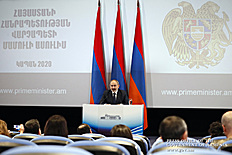 1670x1113px - 380 Kb
1670x1113px - 380 Kb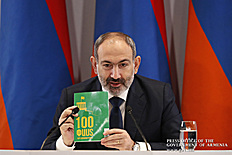 1670x1113px - 429 Kb
1670x1113px - 429 Kb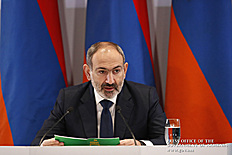 1670x1113px - 376 Kb
1670x1113px - 376 Kb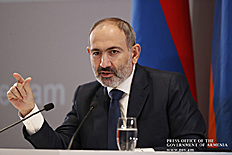 1670x1113px - 405 Kb
1670x1113px - 405 Kb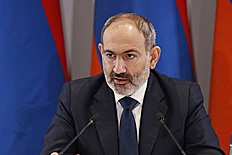 1113x1670px - 378 Kb
1113x1670px - 378 Kb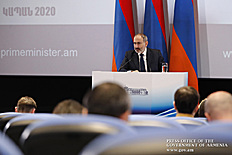 1670x1113px - 345 Kb
1670x1113px - 345 Kb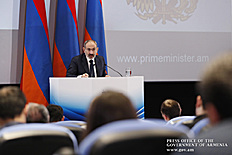 1670x1113px - 334 Kb
1670x1113px - 334 Kb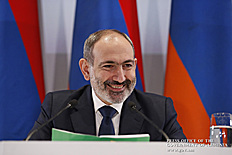 1670x1113px - 394 Kb
1670x1113px - 394 Kb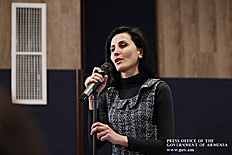 1670x1113px - 426 Kb
1670x1113px - 426 Kb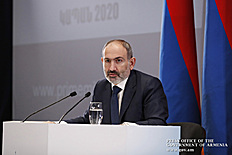 1670x1113px - 327 Kb
1670x1113px - 327 Kb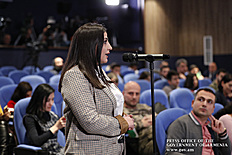 1670x1113px - 604 Kb
1670x1113px - 604 Kb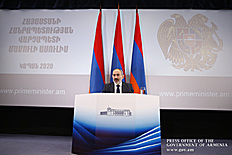 1670x1113px - 456 Kb
1670x1113px - 456 Kb 1670x1113px - 588 Kb
1670x1113px - 588 Kb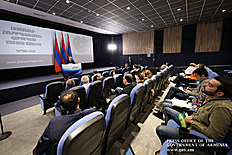 1670x1113px - 775 Kb
1670x1113px - 775 Kb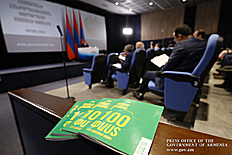 1670x1113px - 573 Kb
1670x1113px - 573 Kb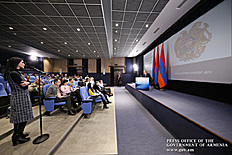 1670x1113px - 805 Kb
1670x1113px - 805 Kb
more 14 photos
Prime Minister Nikol Pashinyan made public 100th facts about New Armenia during the January 25 news conference in Kapan.
1. Over the past two years, in 2018 and 2019, the Government managed to step up tax revenues by 505.4 billion drams, part of which was used to pay off outstanding debt to taxpayers, while the other part went to the state budget’s revenue side.
As of January 1, 2018, the Government owed 275.7 billion drams to taxpayers.
As of January 1, 2020, the debt stood at AMD 76.6 billion, including VAT arrears and debits. That is, the Government refunded some 200 billion drams to businesses within a year and a half. The balance of 305.4 billion of the above 505.4 billion drams supplemented the budget’s revenue side. The process of VAT refunds continues. Thus, state revenues had grown 43.6% as of 2018-2019 as compared to 2017.
2. According to preliminary data for the first three quarters of 2019, Armenia’s GDP growth was about 7.5%, which is 1.6% higher than the index of 2017 and 1.3 percentage points above that of 2018. According to the three quarters’ data, Armenia is the first in terms of economic growth among Eurasian Economic Union and CIS countries, and according to IMF estimates, we are among the first in the European region.
3. The capital expenditures envisaged in the 2020 state budget are 21% up as compared to the actual index of 2017, and 90% as compared to the actual indicator for 2018, and by more than 30% as compared to the 2019 budget. The 2020 state budget bill envisages an increase of about 102 billion drams in capital expenditures, bringing it to 4.1% of GDP instead of 2.5% in 2018 and 3.3% in 2019.
A total of AMD 287.7 billion in capital expenditure is envisaged in 2020. For the first time in the history of Armenia, the Government does not intend to take budget support loans in 2020. External sources include only loans to be used for specific targeted programs that will be discussed and ratified by the National Assembly.
4. Allocations for social development and human capital have increased by approximately 13% in the 2020 state budget. In particular:
• Spending on social protection increased by 20% as compared to 2017, 18% - compared to 2018, and by 11% as compared to 2019, amounting to AMD 492 billion.
• Healthcare spending increased by 37% as compared to 2017, 43% - compared to 2018, and by 24% as compared to 2019, totaling AMD 113.7 billion.
• Spending on education increased by 30% as compared to 2017, 32% - compared to 2018, 14% - compared to 2019, totaling AMD 161.1 billion.
5. Budgetary funding for economic relations in 2020 increased by 51% as compared to 2017, and 74% - compared to 2018, 47% - compared to 2019, and stood at 195.4 billion drams altogether (economic relations imply almost all sectors of economy, including agriculture, irrigation, transport, protection of economic competition and so on).
Housing funding rose by 82% as compared to 2017, twice as much (96%) as in 2018, up 27% from 2019, to AMD 22.9 billion.
6. The 2020 state budget funding for road construction provides for an increase of 64% as compared to 2017, 104% - compared to 2018, and by 91% as compared to 2019, amounting to AMD 110.2 billion. As to the funds earmarked for road construction and improvement, AMD 25.9 billion will be available for continuing the North-South program - 2.4 times more than in 2019, 66% more than in 2018 and 22% more than in 2017. The Gyumri municipal roads rehabilitation program will see 9.4 billion drams allocated in 2020, almost three times as much as in 2019.
7. The funds allocated to this end under the 2020 state budget bill have been augmented more than six-fold in order to fully comply with the Government’s commitment concerning the disaster zone. AMD 3 billion shall be earmarked for giving a final solution to the housing problem in 2020. As a result, the housing needs of 453 households will be addressed. Note that each year an average of 40-45 families used to be provided with housing in the past.
8. Housing issues for 227 families in the disaster zone will be resolved through the provision of home purchase certificates, for which the Government has allocated AMD 1.3 billion in 2019.
9. The 2020 budget envisages 307 billion drams for the Ministry of Defense, which exceeds the actual figure of 2018 by 28% or 66 billion drams, about 4.5% more than in 2017. Since May 2018, the Republic of Armenia has acquired an unprecedented amount of armament and ammunition: Su-30 SM multipurpose aircraft, TOR-M2 KM and OSA-AK anti-aircraft complexes over a comparable period of time.
The armed forces were equipped with artillery, anti-aircraft guns, rifles, ammunition, 310 units of automotive equipment. Tests of various types of weapons were carried out. The Government has turned the shameful chapter of “weaponry that dated back to 1980s,” because the weapons we purchased are either brand-new or were manufactured in 2019.
10. In January-September 2019, foreign investment inflows rose to USD 2,174 million, that is, 465 million or 27.6% more than in the same period of 2018, or USD 635 million or 41% more than in 2017. Foreign direct investment amounted to USD 453.8 million, which is USD 68.7 million or 17.8% higher than in 2018.
11. 57 investment programs worth AMD 212 billion were approved in 2019 as a result of government decisions. 3,320 jobs will be available owing to those investment programs. In 2018, 43 programs were approved to a total cost of AMD 195 billion and 3283 expected jobs. The increase in total investment value was almost 10%.
12. In 2019, foreign currency reserves amounted to USD 2,849 million, 590 million or 26% more than at the end of 2018, and USD 535 million or 23% up the figure of 2017.
In 2019, the Central Bank bought USD 565 million and did not sell foreign currency. This is an exceptional indicator in the history of the Third Republic, which backs the reliability and stability of Armenia’s financial system.
13. We had the third issue of Eurobonds, worth USD 500 million and with 10 years maturity. The coupon yield of the new issue bonds is only 3.95% instead of the 6% of the redeemed bonds, which means that the bond servicing costs have significantly decreased for Armenia. This fact alone may lead to annual savings of about USD 10 million while servicing the country’s foreign debt.
14. 81,534 new jobs were created (generated or taken out of shadow) by the end of 2019 as compared to May 2018.
Our surveys have shown that the share of high-paid jobs is increasing in the total amount of emerging jobs, which evidences a profound and positive transformation in Armenia’s economy.
15. The employment rate rose to 49.3% in the third quarter of 2019, from 46.8% in 2018 and 46.3% in 2017, respectively. The actual employment rate has increased by 2.5 percentage points within a year’s time. Meanwhile, in the third quarter of 2019, the unemployment rate in Armenia dropped to 18% instead of 20.1% in 2018 and 19.9% in 2017.
16. 120 million 36,800 or 38% more cash-register receipts were issued last year than in 2018. As a result, trade turnover of 345 billion 413 million drams or 21.9% was recorded as compared to 2018.
17. In 2019, 230 IT companies received tax benefits, including about 30 companies from the Diaspora, with more than 1,200 new jobs created in the sector. Bids to that effect have been received from France, the United States, Russia, Austria, Georgia, Switzerland, Iran, Germany, the United Kingdom and the Netherlands. 47 companies from 17 countries (Georgia, Belarus, China, the Czech Republic, Estonia, Germany, France, Great Britain, Malta, Ireland, Poland, Spain, Lebanon, South Korea, Russia, UAE, USA) have come to Armenia. The winners will be eligible for a grant and will get the opportunity to live and work in Armenia.
18. In January-September 2019, the number of inbound tourist visits to Armenia totaled 1,459,152, or an increase of 14.4% as compared to January-September of the previous year. The number of tourists visiting Armenia from the Russian Federation increased by 76.2% in January-September 2019, 2.2 times –from Germany, 2.3 times –from France, 62.8% - from Italy, 98.6% -from the Netherlands, 13.3% - from Iran, 11.7% - from Georgia, 43.8% - from Canada, and 31.7% - from Ukraine. Domestic tourism visits increased by 45.7% in January-September, 2019 as compared to the same period last year.
19. In 2019 4 million 319 thousand 618 people arrived in Armenia.
In 2018, 3 million 757 thousand 187 people arrived in Armenia.
In 2017, 3 million 398 thousand 137 people arrived in Armenia.
921 475 people, or 27.1% more, arrived in Armenia as compared to 2017. The number of arrivals to Armenia in 2019 is 10,506 more than the number of those leaving.
20. A number of reputable foreign organizations and periodicals have included Armenia and Yerevan among their preferred tourism destinations. In 2020, Armenia was cited in the top ten exotic tourism destinations by The Telegraph, the Financial Times, and the American Forbes. Booking.com has included Yerevan in the top ten most active tourist destinations in the world in 2020. According to Condé Nast Traveler magazine, Armenia was included in Top 20 Travel Destinations in 2020.
21. In January-November 2019, Armenia’s exports increased by 9% as compared to the same period in 2018, amounting to USD 2,401 million. Imports increased by 6.6% to USD 4,830 million. The Republic of Armenia will have a customs attaché at Upper Lars international checkpoint.
22. The Government has approved a state support program for small and medium-sized greenhouse farms, which will enable our farmers to build new greenhouses that meet modern technological requirements, as a result of which we will switch over from low-cost to high-value agriculture.
Over the next 3 years, greenhouse farms will be developed on up to 35 hectares, crop yields and hothouse output will be up by about 3600 tons per annum, with reduced costs, increased incomes, etc. The program will cover about 1/3 of the costs of greenhouse construction, and half the cost for border village residents and people with disabilities.
23. According to operational data for eleven months in 2019, nearly 8000 loans to a total value of 32 billion drams have been provided under the agricultural loans subsidy program. The number of beneficiaries and the amount of loans went up by 73% and about 61% respectively, as compared to the same period last year. Loans are provided within the range of 3 to 15 million drams at 0% interest rate in border settlements, 3% - for agricultural cooperatives, and 5% - for other business entities.
24. In 2019, the state support program intended for setting up state-of-the-art intensive orchards and vineyards has been amended; AMD 347.8 million-worth 13 loans were made available for a total area of 32.2 hectares for orchards; the amount of subsidy was AMD 38.8 million. One of the beneficiaries was provided AMD 7.04 million in compensation for a 1-ha-wide orchard.
Only one person benefited from the program last year. These project loans are provided at 2%; 0% in border villages, 0% for agricultural cooperatives establishing more than 3 hectares. 50% of the cost is reimbursed in case of 0.5 to 10 hectares.
25. In 2019, the State Support Program for the Construction or Reconstruction of Small and Medium-Sized Smart Sheds and Their Technological Provision was launched; 104 citizens were certified and 12 compensation contracts were signed. Under the program, the state reimburses 50% of the cost of construction or reconstruction of smart animal farms for ordinary farmers, and 70% for borderline villages and servicemen with disabilities.
26. The Cattle Breeding Program for 2019-2024 has been launched, under which 304 animals have been acquired to a total cost of AMD 391.0 million, with 9.0 million dram subsidies.
The 2019-2023 Sheep and Goat Breeding State Support Program has been launched: 203 animals have been purchased. One AMD 78.9 million-worth credit facility was made available to this end. The loans are provided at 2%, and at 0% for border village residents and agricultural cooperatives.
27. In 2019, 210 beneficiaries were provided with 357 units of agricultural machinery, including 157 tractors, 4 units of combine harvesters, and the lease amounted to 1.7 billion drams, with a subsidy amount of 129.5 million drams. The number of leaseholders and agricultural equipment has increased by 1.7 times as compared to the same period of the previous year. Citizens can get loans at 2% interest rate under this program.
28. Exports of a number of agricultural products in 2019 have significantly increased as compared to 2018.
• Apples - 3240 tons or 32%
• Cherries - 1440 tons or 35%
• Royal orange - 2000 tons or 96%
• Mulberries, figs, currants, blackberries - 700 tons or 86%
• Strawberries, raspberries - 725 tons or 172%
• Cherry - 150 tons or 27%
• Tomatoes - 4300 tons or 23%
• Cucumbers - an increase of 6600 tonnes or 266%
• Cauliflower, broccoli - 1500 tons or 45%
• Radish - 730 tons or 58%
• Mushrooms - 840 tons or 148%
• Pepper - 280 tons or 47%
• Eggplant - 600 tons or 657%
• Watermelon, melon - 225 tons or 50%.
29. Negotiations that lasted almost a year completed successfully; an agreement on transit of livestock exports through Iran was concluded. Businessmen will no longer have to pay huge amounts to export livestock to Iran, Iraq, Kuwait, the United Arab Emirates, Qatar and elsewhere. I can state with confidence that animal exports will increase sharply to promote livestock development.
30. Since September 30, 2019, Armenia has been implementing a pilot agricultural insurance program, which provides for grape and apricot crop insurance, covering hail, fire and spring frost risks for some 30 thousand hectares in 6 regions of Armenia, prerequisites for full implementation of agricultural insurance will be created.
At least 50% of farmers’ costs will be covered by the state; 60% of frost risk insurance shall be offered to domestic farmers.
31. The tariff set for the customs clearance of postal packages shipped from Armenia (2250 AMD) was canceled, enabling small and medium-sized businesses to make more effective use of e-commerce and export opportunities.
32. A one-stop-shop investment support center has been launched to assist local and foreign businessmen willing to invest in Armenia with the applicable formalities and will provide comprehensive support in many areas, ranging from opportunities and conditions in the sector to operational response to emerging problems.
33. In 2019, 350 km of highways were built and renovated, including 110 km road sections rehabilitated under subsidy programs, about 460 km roads altogether. More than 350 kilometers of roads of national importance underwent capital repairs in 2019, as much as in 2015, 2016, and 2017 altogether. In fact, in one year there has been as much work as in the past 3 years.
34. 462 subsidy programs totaling AMD 16.3 billion have been approved for the development of economic and social infrastructure in communities. Construction and equipment acquisition for 382 projects has been completed. Water mains were repaired and rebuilt in 46 communities to a total cost of about AMD 860 million. 10 billion drams were earmarked from the state budget for subsidy programs in 2020.
35. Thanks to the measures aimed at getting economic entities involved in waste management activities in the provinces, the number of contracts for the provision of waste management services has increased by about 220% as compared to the beginning of 2017.
To build capacity on the basis of communities’ own potential, 24 enlarged communities have been provided with AMD 1.2 billion-worth 44 units of utilities and 25 units of agricultural machinery through the Regional Development Fund of Armenia.
36. The vehicles customs clearance checkpoint has been moved to the SRC North Customs Department in Gyumri. As a result, the flow of vehicles imported from third countries is now processed in Armenia’s second largest city. 189,018 cars were imported in 2019, three times as many as in 2018.
37. During 2018, the Government managed to reduce the poverty rate by 2.2 percentage points to 23.5% as compared to 2017, which is the lowest-ever indicator recorded in this area. At the same time, the number of extremely poor has decreased from 1.2% in 2017 to 1%. Economic growth was the most important factor behind the decline in poverty in Armenia. It should be emphasized that the poverty level in Armenia is estimated in accordance with the World Bank’s revised number three methodology applicable since 2009.
38. New birth and young family support programs will be effective as of July 1, 2020:
• The lump sum birth allowance for the first child will increase six-fold, from 50,000 to 300,000.
• The lump sum birth allowance for the second child will increase twice to 300,000 drams from 150,000 drams.
• As of July 1, 2020, the amount of childcare allowance shall be 26,500 instead of 18,000.
• An additional allowance of 26,500 drams for a parent living in the countryside will be applicable as of July 1, 2020. That is, a parent living in a rural area and at the same time a hired worker, if he / she is under the care of a child under the age of three, shall be entitled to a care allowance of 26,500 drams as a hired worker and 26,500 drams in a rural area, in total the beneficiary will receive 53,000 drams.
• Preschool institutions and schools will provide co-funded extra daycare and classroom services from 08:30 to 19:00.
• The State shall provide lump sum financial assistance and prepayment insurance for childbirth-induced mortgage loans in the provinces.
I would also like to advise that the procedure of providing medical care to children under the state order has been simplified. Medical facilities will no longer require a child health certificate
39. The minimum full-time salary for teachers is set at 108,000 drams; depending on the number of students, the salaries of some schools may be higher. On January 1, 2020, a new procedure for providing transport services to teachers and school-age children at secondary schools has come into force, under which compensation will be provided to traveling teachers and pupils in the provinces. For this purpose, 3.5 times more money will be allocated from the state budget. The program implies compensation for 3,000 teachers and 1,000 students. In addition, the Ensuring Access to Higher Education in Yerevan for Students Living in the Region program has been approved, under which larger groups of students can benefit from discounts on accommodation services.
In 2019, training courses were organized for 2498 teachers from 342 schools. Trainings were administered in “Me and the surrounding world,” “Mathematics,” “Algebra” and “Social science” academic subjects.
40. A new procedure for granting general school students individual scholarships is applicable as of January 1, 2020. Students of general educational institutions participating in the finals of international subject Olympiads, other international school Olympiads or the winners of national finals of Republican Subject Olympiads in the Republic of Armenia may get monthly scholarships of specified size during the following academic year.
The amount of scholarships will vary from 5 to 25 thousand drams per month. A state scholarship will be awarded to young Armenian entrepreneurs to study in Silicon Valley. The Ministry of High-Tech Industry will cover all expenses related to the training of 45 young entrepreneurs.
41. Since January 1, 2020, the salary of approximately 950 emergency medical personnel in Yerevan has increased by 10%. Staff at music and art schools, youth creative centers in Yerevan saw their wages up by 25%, while the salaries of sports school employees increased 56% as of January 1, 2020. The employees of sports and cultural institutions will benefit from health insurance facilities. The salaries of about 5,000 people have increased in this area.
42. Yerevan’s budget will exceed the actual budget of 2017 by 48%, 56% up the budget of 2018, and 30% - that of 2019. For the first time, the expected revenues will exceed the mark of 100 billion drams, amounting to more than 107 billion drams. Thus, the city’s own revenues will be increased by 3 billion (17.5%).
43. Mortgage loan portfolio of commercial banks and credit organizations amounted to 238 billion drams by the end of 2017 (29 thousand loans). As of the end of 2018, the balance of the mortgage portfolio amounted to 285 billion drams (33 thousand loans), 20% up over the previous year. By the end of 2019, the balance of mortgage portfolio amounted to AMD 393 billion (41 thousand loans), increasing by 38% over the previous year.
The volume of new mortgage loans granted by commercial banks alone amounted to 83 billion in 2017, AMD 101 billion in 2018, and 165 billion in 2019. Mortgage loans increased by 99% in 2019, as compared to 2017.
According to the above, the mortgage program loans provided by National Mortgage and Housing Youth organizations amounted to 16.9 billion drams in 2017, 17.7 billion drams (1817 loans) in 2018, and 25.0 billion drams (2339 loans) in 2019, In other words, this program saw a 48% growth in 2017, as compared to 2017.
Yerevan stands on the verge of a construction boom. During 2019, 2612 construction permits were issued. As compared to 2017, the number of construction permits increased by 813 or 45%, and by 1132 or 76%, as compared to 2018.
Housing projects are underway in other cities of the country
44. The amount of income tax refunds to individuals applying for mortgage interest payments has increased substantially. In 2019, the number of borrowers rose to 2,568, increasing by 64% as compared to 2018, and by 180% - compared to 2017. 7.9 billion drams were returned to borrowers in 2019, which is 69% more than in 2018 and 227% against the index of 2017.
45. The average salary of Rescue Service staff has increased from 85-90 thousand AMD up to 130 thousand AMD. Since October 1 the salaries of 99 forest chiefs and 512 forest guards have increased by 20%. For the first time, all employees were provided summer and winter clothing.
46. The minimum wage for those working in specialized care or social rehabilitation services for persons with intellectual disabilities (including autism) has increased by 30% since January 1, 2020.
47. On January 1, 2020, the minimum wage increased from 55 thousand to 68 thousand drams. As a result, the average salary has increased by about 20% for about 130 thousand employees. As of January 1, 2020, about 272,000 citizens will see their salaries up owing to the flat income tax system. As a result, the amount of extra money that citizens will have will increase from 2.5 to 4 billion drams a month.
48. By Government Decree AMD 1.9 billion has been earmarked to provide home purchase certificates to about 300 orphanage graduates. Priority beneficiaries of the project have also been included in state employment programs. Thus, the government has complied with its commitment assumed as early as in 2003.
49. In 2020, the Yerevan Municipality will launch a social housing program, under which a 16-18 storey building will be built mediating the amounts saved in 2019. The new residential building will accommodate the residents of 2-3 emergency buildings. Those five-storey emergency buildings will be demolished and offered to developers with investment plans; high-rise buildings will be built instead, in which the Town Hall will have a share equivalent to said five-storey buildings. With this model the municipality intends to solve the problem of emergency buildings in Yerevan in the coming years.
50. About AMD 1.5 billion will be made available with a view to addressing the housing needs of 112 families displaced from Azerbaijan. For over 10 years, the government had done almost nothing to tackle the problem.
51. By Government Decree, 1,000 families included in the Family Benefit System will receive support for cattle-breeding
The program’s goal is to provide sustainable income for beneficiaries, as well as to preserve the right of such families to family or welfare benefits for the next 12 months. About AMD 700 million shall be earmarked to this end. Beneficiaries will receive 350,000 drams for livestock, 230,000 drams for feed. The beneficiaries and veterinarians will get a minimum monthly wage of 50% and 20% respectively.
52. As from January 1, 2020, the Government will reimburse the rent of consumed natural gas, electricity and water supply for single pensioners residing in the Social Housing Fund of Armenia. As of December 1, 2019, 63 single pensioners used to live in shelters.
53. Since January 1, 2020, the Military Insurance Fund has started the process of providing assistance to the families of those servicemen who were killed during defense operations or got 1st or 2nd group disabilities back to January 1, 1998.
Over the past year and a half, the range of support provided by the Fund has expanded to include 19 more cases. As of May 2018, the Fund gave compensation only for events that came after January 1, 2017.
In addition, the government approved and submitted to the National Assembly a draft law, which provides the right to compensation for damage to life and health of servicemen not directly involved in fighting operations, caused as a result of adversary attacks.
54. More than 8 billion drams were allocated in 2018-2019 to address the housing needs of army veterans. The program is to be continued. Under Defense Ministry’s housing program, 3 residential buildings have already been commissioned in Goris (20 apartments), Sisian (28 apartments) and Vayk (44 apartments).
55. In 2019, Armenia’s Higher Qualification Committee approved 6 doctoral and 216 doctoral degrees. The number of defenders of scientific degrees has decreased significantly as compared to previous years, in particular, in 2018 there were 42 doctoral and 317 doctoral degrees, and in 2017 - 41 doctoral degrees and 353 doctoral degrees.
56. In 2019, we had over 1,230 thousand visitors to subordinated to Ministry of Education and Science-affiliated museums, which is 18% or 18.6 thousand more than the number of those who visited museums in 2018, and 33% or 30.7 thousand more than the number of people who visited museums in 2017. During the Holiday Season, 14 thousand 662 people visited our museums, which were open on those days. 11,916 people purchased tickets, while 2,746 visitors under 18 benefited from the government-administered right of free access to museums.
57. We have introduced a tradition of concluding the year with a classical concert, which is accepted in some countries. On December 31, the State Symphony Orchestra of Armenia performed a festive concert in the crowded hall. About 20 performances were organized for children, adults and families during the holidays. The number of theater visitors rose by 25% during the New Year. From December 29, 2019 to January 7, 2020, 54,802 people visited theaters in Armenia, of which 51,014 purchased tickets and 3,788 were by invitation.
58. Funding for the following cultural institutions has increased by AMD 700 million, as a result of which they have become fully state-funded;
• National State Choir of Armenia,
• National Philharmonic Orchestra,
• State Symphony Orchestra,
• Komitas National Quartet,
• National Jazz Orchestra of Armenia,
• “Hover” National Center for Chamber Music;
• Tagharan Ensemble,
• Yerevan State Chamber Choir,
• Chamber Orchestra,
• Chamber Choir.
59. The water intake quota from Sevan was the lowest for the past 10 years. 143.8 million cubic meters of water was released from Lake Sevan for irrigation purposes, which is 56 million cubic meters less than in the same period last year. 170 million cubic meters were specified in the law, but 26,140 million cubic meters less water was released as a matter of fact. As a result of legislative changes, the Government can now apply to the National Assembly for additional intake from Lake Sevan only in case of an officially stated drought.
60. Electricity consumption in Armenia increased by 5.8% as compared to 2018 in the first nine months of 2019. It is noteworthy that in January-November of last year the volume of electricity produced by solar power plants increased by 2.6 times compared to the previous year, and the output of wind power plants - 2.1 times.
61. The Ministry of Environment has initiated a USD 2.5 million worth international grant project to be implemented in the communities of Dilijan, Fioletovo, Margahovit and Urtsadzor adjacent to Khosrov Forest State Reserve and Dilijan National Park. The project has socio-economic content to show other sources of income to the inhabitants of the forests and to support them.
The Government’s 10 Million Tree Planting Project, which seeks to have 10 million trees planted throughout Armenia by October 10, 2020, has already entered a practical phase. Some companies have expressed willingness to participate in tree planting. Relevant arrangements have been made on import of seedlings from Iran, Belarus, Russia, Kazakhstan and Georgia.
In 2019, for the first time 424 million drams were allocated from the state budget to HayAntar SNCO for forestation and reforestation purposes.
• 150 hectares of forests, including 10 hectares of sowing, 140 hectares through planting;
• Natural growth of 200 hectares through mineralization;
• 460 hectares of stony areas restoration,
• Completion of 26 ha of forest crops established in previous years,
• 5.8 hectares of nursery sowing;
• 28,000 kg of forest seeds harvested.
Purchased were:
• 8 tractors
• 8 forest plows
• 8 agricultural plows
• 4 holes
• 21 tons of peat.
940 people were hired for seasonal work.
62. Charcoal imports increased by 6.2 times, or by more than 500% as compared to 2017. The number of importers increased by 22.6%, 53 companies in 2017, and 65 companies in 2018. As for timber, as much timber has been imported over the ten months of 2019 as all the way through 2018. Compared to the annual results of 2017, 77% more timber was imported, and the number of importing companies increased by 51.4% or 70 companies in the first ten months of this year, a total of 206 companies against the previous 136. These figures mean that the Government’s forest protection policy is effective.
63. Armenia has recently been actively engaged in the collection and processing of outdated cars’ body parts. In August-December 2019, the skeleton of about 21,000 abandoned cars was collected. Work in this direction continues.
64. The amounts recovered during the 2019 activity of the Special Investigation Service amounted to 4,331.9 million drams. The amount recovered last year alone is 7 times more than the public funds recovered in criminal cases examined in the service over the past 11 years, which totaled 597.6 million drams.
This is only the amount of cash money returned to the state budget. By far much is the cost of assets encumbered or confiscated due to legal proceedings, as well as such movable or immovable property as may be associated with crime and will have to be administered on the basis of judicial acts.
Golden Palace Hotel in Tsakhkadzor has become state-owned, and is currently auctioned at AMD 7.5 billion starting value.
65. In 2019, the State Revenue Committee’s subdivisions collected 62.6 billion drams in budget receipts, against 30.6 billion drams in 2018, and 26.8 billion - in 2017.
66. Instances of illegal child adoption by foreigners, committed with gross violations of RA legislation, have been identified. According to the facts, 2 Armenian citizens, mediating their contacts in a central maternity hospital, as well as in a number of agencies and orphanages, have arranged the adoption of over 3 dozen children of Armenian citizenship by foreign citizens in gross violation of the applicable legislation.
67. In the past two years, criminal proceedings were launched on 254 cases of embezzlement or other corruption cases related to persons fraudulently registered in state- or community-funded institutions, who signed for wages disbursed in their names. 543 registered persons were identified under criminal cases, 222 of them were employed in educational institutions.
68. In October 2019, a pilot project kicked off for delegating to private entities the catering services at Nubarashen and Armavir penitentiaries. The proportion of inmates and detainees is 100%, and its consistent implementation will ease the burden on the families of persons held in penitentiary institutions.
69. Since January 1, 2020, the High Road Traffic Regulation System has been introduced with the aim of enhancing the effectiveness of administrative liability policies in the area of traffic safety by excluding the components of prosecuting and penalizing former citizens.
The new system is aimed at the general and individual prevention of administrative offenses, ensuring the corrective function of administrative measures, as well as reducing the social burden of RA citizens. Now the maximum fine is 29,000 drams instead of 500,000 drams.
70. During the three quarters of 2019, there has been a significant reduction in the level of losses in natural gas transmission and distribution systems in Armenia, as well as in high voltage and distribution networks. In particular, the level of losses in natural gas transportation and distribution systems decreased by 0.8 percentage points as compared to 2018, by 1.8 percentage points - compared to 2017, and by 2.5 percentage points - compared to 2016. Losses in the power distribution network decreased again by 0.8% as compared to the same period in 2018, by 1.7% - compared to 2017, and by 3.1% - compared to 2016.
71. Additional 984 million drams were allocated in 2019 for military-industrial, scientific-research and experimental design programs. Thus, military industry allocations increased by about 30% in 2019.
72. As part of an army catering pilot program, private partners are servicing more than 40 military units. Honey, fat, garlic and black pepper were provided to improve the nutrition of the fighting positions.
Work continues to improve the quality and comfort of uniforms and footwear. This program improves not only the food of the servicemen but also the social status of their parents, as parents do not have to spend money on their children’s service. Military units are provided monthly funds for unforeseen expenses to cover daily expenses.
73. From September 24 to October 5, 2019, unprecedented maneuvers were held in Armenia and Artsakh. An important result is that not only has our people’s confidence increased in the armed forces and organizational resources, but also the confidence of our troops has augmented in their own skills.
74. The U.S. House of Representatives and the Senate have adopted resolutions recognizing and condemning the Armenian Genocide. It should be noted that the U.S. Congress’s recognition of the Armenian Genocide is the result of combined lobbying and diplomatic efforts, as well as that of favorable geopolitical realities.
75. On 17 October Armenia was elected a member of the United Nations Human Rights Council 2020-2022, the main body for the promotion and protection of human rights worldwide. Armenia received the largest number of support from 144 countries in its regional subcommittee at the UN General Assembly, indicating a significant increase in Armenia’s international credit as a result of democratic changes. The UN has unanimously adopted a resolution declaring July 20 as International Chess Day, co-authored by Armenia and co-authored by 54 countries.
76. During 2019, Armenia successfully chaired the bodies of the Eurasian Economic Union. The Prime Minister of Singapore, the Presidents of Iran and Moldova participated in the October 1 Eurasian Economic Council meeting in Yerevan in addition to EAEU leaders. EAEU and Singapore signed free trade and economic cooperation agreements to boost trade between the countries of the Union and one of the most powerful economies in the world. The Summit held in Yerevan on October 1, 2019 was unprecedented in its history.
77. On October 6-9, 2019, more than 2,500 specialists from over 70 countries, as well as ministerial delegations from 20 countries arrived in Armenia within the framework of the World Summit on Information Technologies. Many renowned international media outlets described Armenia as a high-tech country. In 2019, during the last quarter of the technology exhibitions held in Qatar, Singapore and Uzbekistan, about 27 companies came up with a single Armenian pavilion that resulted in 9 memoranda, over 200 agreements with more than USD 7 million in new export opportunities.
78. In November 2019, the visa requirement was waived by Serbia and Qatar for Armenian citizens. The Agreement on Mutual Abolition of the Visa Requirement with China entered into force on January 19 this year. Sweden, Slovakia, Serbia and the Netherlands made a decision to open an embassy in Armenia.
79. RA Armed Forces continue to participate in international missions, including Armenia’s humanitarian missions in Syria, where our specialists have de-mined 124,000 square kilometers since the start of the mission. Humanitarian doctors have provided therapeutic and surgical care to over 8,500 local residents.
80. The dynamics of RA citizens and organizations participating in the Pan-Armenian Fund Marathon is as follows: 3240 in 2017, 5994 in 2018, and 9644 in 2019 (more than 60% increase over last year’s attendance, and 197% as compared to 2017).
81. For the first time in the history of Armenia, several budget airlines entered the Armenian market at once. As a result, ticket prices to Europe start at 19 euros. 6-7 European destinations used to be served before the non-violent velvet popular revolution in 2018. The following legislative amendments resulted in the bids for 10 new destinations filed by the airlines listed below:
• Paris Orly Airport, Transavia
• Vienna, Wizz air
• Vilnius, Wizz air
• Berlin, Ryanair
• Memingen (from Gyumri), Ryanair
• Rome, Ryanair
• Milan, Ryanair
• Athens (from Gyumri), Ryanair
• Thessaloniki, Ryanair
• Riga, Air Baltic.
82. For the first time in January-September 2019, the number of RA citizens seeking asylum in the EU decreased by 29% as compared to 2018, 47% - compared to 2017, and 51% - compared to 2016. The number of RA citizens who applied for asylum in EU countries in the first 9 months of this year was 2670.
83. After a long break, Fitch Ratings upgraded Armenia’s sovereign rating from B + to BB- with “stable” outlook. Raising the rating is very important in the sense that Armenia will be able to attract relatively cheaper borrowings or refinance loans from the international capital market on more affordable terms, and second, by seeing its rating up, Armenia will become more reliable and attractive to investors. In August, Armenia’s sovereign rating was raised by Moody’s rating agency, making it Ba3 from B1.
International financial and economic institutions have raised Armenia’s economic growth estimates and forecasts for 2020 and 2021, while the forecasts for the global economy and the regional countries were substantially lowered.
The World Bank and the International Monetary Fund have predicted that Armenia will improve its exports and investments in the next couple of years, and, on the other hand, will reduce poverty and unemployment.
84. According to a 2019 Freedom House report, Armenia ranks eighth in the world in terms of internet freedom index, with France sharing the eighth position in the world. By this index Armenia is the leader in the region.
85. One of the most prestigious magazines in the world, Time, was impressed by Armenia’s economic results in 2019, calling Armenia “Caucasian Tiger” in one of its year-end issues.
86. According to the British Legatum Analytics Institute’s 2019 Prosperity Index, Armenia improved its position by 7 points within a year, ranking 61st among 167 countries. Armenia had not had such a high survey rating over the past 10 years.
87. According to the Gallup American Institute’s annual Law and Discipline 2019 report, Armenia ranks 7th among the safest countries, sharing it with Switzerland.
Overall, Armenia scored 85 on the Security Index, sharing the 11th position with a number of European countries, Japan and Saudi Arabia.
88. According to the UN World Food Organization (FAO) monthly report, world food prices had recorded an increase of 6% by October 2019, while food and non-alcoholic beverages in Armenia boasted a 0.3% deflation as compared to the same period in 2018. This is clearly the result of the Government’s anti-monopoly policy.
89. The principles of selection of senior staff in Armenia have changed. A candidate nominated by the opposition was elected Chairman of the Anti-Corruption Commission. The head of the Cadastre Committee was selected from the Human Resources Bank.
90. The Government allocated AMD 271 million to the Yerevan Town Hall for organizing the New Year festivities. Among other factors, as a result of this allocation, we can note that during the period from December 28 to January 6, we had additional turnover of 9 billion 307 million drams as compared to the previous year, of which 4 billion were spent in the provinces. As a result of the surplus turnover recorded in this period, we expect AMD 325 million in extra budget receipts.
On the night of December 31, the Prime Minister’s New Year’s message to the nation was broadcast live from the crowded Republic Square.
More than 20,000 people attended the rally convened by Prime Minister Nikol Pashinyan in Grand Park, Los Angeles. No such large-scale event with the participation of an Armenian leader had ever taken place in the Diaspora
91. For the first time in Armenia’s history, the incumbent head of state reported to the investigator’s office for inquiry at the Investigative Committee’s invitation.
92. The Government of Armenia has made a decision to donate 10 new ambulance vehicles to Artsakh. Funded from the state budget of Armenia, the vehicles will be in Artsakh by this March.
93. In 2019, the Armenian Army stated a historic low rate of service-related casualties.
94. In January-September 2019, Armenia’s 1000 largest corporate taxpayers declared AMD 764.5 billion in fiscal contributions, which is 90.7 billion drams or 13% more than in the same period of 2018. The taxes paid by large taxpayers rose by AMD 185.5 billion or 32% as compared to January-September 2017.
95. The Hero of Our Times award ceremony was held in Gyumri on 21 September. For the first time, a hard-working person was encouraged at the state level in our country. Organized by the Prime Minister’s Staff, the award ceremony featured 13 middle-class businessmen as winners.
The Prime Minister himself handed in the main prize. The Hero of Our Times award ceremony will be held annually, this year’s event will be hosted by Vanadzor.
96. In 2019, 320 new computers were acquired for judicial staff to replace the ones in service since 2005. All Armenian judges will have new computers owing to this initiative.
97. Under a program co-financed by the My Step Foundation and the Government, about 1,000 children from marz-based vulnerable families came to Yerevan on New Year’s Eve for a visit to theaters and children’s entertainment centers.
Similar programs are being implemented not only during the Holiday Season, but also on other occasions. Some 2800 children have benefited from the program since 2018 by visiting museums, theaters, entertainment centers, and parks.
98. Following the non-violent velvet popular revolution of 2018, the number of service cars decreased by 448. Armenia is at a historical low level in terms of service cars.
99. According to IMF analysis / forecasts, Armenia overrun Georgia in 2019 and will surpass Azerbaijan in 2020 in terms of per capita GDP.
100. An extra amount of 71.6 billion drams has been envisaged in the 2020 State budget bill to raise salaries for military servicemen, rescuers, foresters, teachers, raise minimum wages, increase pensions and benefits.
A total of 1 billion drams was allocated to raise the salaries of several public officials holding senior positions, which makes up 1.4% of the aforementioned amount.
* * *
During the press conference, Prime Minister Nikol Pashinyan answered journalists’ queries, including questions on the Nagorno-Karabakh conflict settlement process, in particular, the former authorities “legacy” and the statements made by their representatives.
“They keep insisting that the Government is not pursuing a pro-Armenian policy on Artsakh, and if Artsakh’s new president does not oppose to Armenia’s authorities, it may pose a threat to Artsakh. They have begun to circulate the thesis that we have wasted Serzh Sargsyan’s valuable legacy.
Now, let us see what Serzh Sargsyan’s “legacy” is concerning the Karabakh issue.
Recently, a media outlet published an article that essentially quoted the document as to where Serzh Sargsyan had left the negotiation process, and at least we saw no denials on the part of former officials. And I think we can therefore make some conclusions about Serzh Sargsyan’s legacy as to what he has left on the table negotiations.
Paragraph one: Three main paragraphs. I quote: “The ultimate goals of a comprehensive settlement of the Nagorno-Karabakh conflict stand in the same way as they are interconnected.”
The objectives: the goals are the settlement of the Karabakh issue. This is the legacy left by Serzh Sargsyan.
“The return of seven regions - Aghdam, Fizuli, Jebrail, Zangelan, Zubatli, Kelbajar and Lachin to Azerbaijan, provided that a corridor linking Nagorno-Karabakh to Armenia is maintained.”
And the next paragraph: “The determination of the final legal status of Nagorno-Karabakh, which shall be legally binding and in conformity with the norms and principles of international law through the vote based on the free will of the whole population of Nagorno-Karabakh within a time-limit agreed upon by the Parties under the auspices of the United Nations or the OSCE, taking into account that the questions should not be restricted and may include all status options. Complete regulation of political, trade, economic and humanitarian relations in the region, restoration of positive cooperation, ensuring full stability in the South Caucasus region.”
Paragraph 2: “Assisted by the international community, the re-settlers shall leave the five regions specified in the first paragraph.
Azerbaijani civilian authorities will enter the area after the international peacekeeping forces have been deployed and the armed forces currently stationed have been withdrawn from those areas. International peacekeeping forces will be located along the administrative boundaries of the former Nagorno-Karabakh Autonomous Region, with the exception of some sections in Kelbajar and Lachin regions. The region of Kelbajar will remain under OSCE’s transitional monitoring.”
Paragraph three. “At the same time, along with the aforementioned measures, Nagorno-Karabakh should be granted a temporary status, which will guarantee the organization of its day-to-day life until a final settlement.”
This is just the “legacy” we have got from the former authorities. Now we are accused of wasting that “legacy.” I would like to state the following in this connection: should the Republic of Armenia wish to continue the talks from this very point, the international community will not create any problems, no, absolutely no.
Now, I would like to see whether this text is acceptable to Artsakh’s presidential candidates. Let the people of Artsakh say whether this text is acceptable or not. Let the Armenian people say this text is acceptable or not.
If the people of Artsakh, the people of Armenia decide that this is an acceptable option, the right content of negotiations, I can guarantee that it will appear on the table of negotiations. We will have absolutely no problems.
Now I propose and insist that all the candidates for the Artsakh President say whether this is acceptable or not. This is extremely important for doing away with any kind of speculation, since when I became prime minister, I was offered to continue the negotiation process from the point where Serzh Sargsyan had left it. I made public my view in Stepanakert at the March, 2019 joint session of the Security Councils of the Republic of Armenia and Artsakh.
And I want to say that no government in Armenia has been as transparent about the Karabakh issue as our government and myself. But what I was saying was that all the candidates for the Artsakh elections should say whether this “legacy” is acceptable to them, and whether they believe that today the Prime Minister of the Republic of Armenia should take this as a legacy and continue the negotiations. I guarantee that they will not face any problem if they happen to say yes.
* * *
Public TV - Artur Khachatryan: If I am not mistaken, you should leave for Munich in February, where an international conference on security will take place. The President of Azerbaijan will be in attendance.
Is there a meeting scheduled with Ilham Aliyev and is there a likelihood of a meeting on the matter at hand. One and a half years after the elections, we still do not know whether the negotiations continue. If so, what are you negotiating at what stage?
Prime Minister Nikol Pashinyan – We have not yet made an arrangement for such a meeting. The meeting cannot be ruled out because we are in the process of discussions. In general, let me tell you that we met in St. Petersburg on December 20, 2019, during the CIS meeting? I find such contacts useful. That is, if in principle there is an opportunity to speak, discuss, I think it is not harmful, it is useful.
What about negotiations? Again, I consider it important, dear journalists, dear compatriots, to record that you all know what I was talking about behind the closed doors with Ilham Aliyev. This is described in my speech delivered at the joint meeting of the Security Councils of Artsakh and Armenia in Stepanakert on March 12, 2019, where I outlined the scope of our discussions in the negotiation process.
We are now talking about that framework. At the moment there is no concrete document on the table of negotiations. And we need to work together on the way to more substantive talks, but we must use this period very effectively to approach that stage. After all, as to whether we used it effectively, I think we have not used it too effectively for a number of objective and subjective reasons.
One of the most important reasons is that, unfortunately, the Azerbaijani side does not make a statement equivalent to my statement that the settlement of the conflict should be acceptable to the people of Armenia and Karabakh, and the people of Azerbaijan.
This is, today, at the conceptual level, the biggest obstacle to the settlement process, but our position is constructive, and we believe that the Karabakh issue must be settled within the framework of the concept and principles I voiced in Stepanakert and at the UN headquarters. And we are ready for constructive, normal proceedings, no matter how well we see the challenges ahead. It is just our responsibility.
I have specifically told our partners that the President of Azerbaijan, the President of the Republic of Artsakh and the Prime Minister of the Republic of Armenia are responsible for peace and stability and the future in the region,
This is a personal responsibility and in some ways a shared responsibility. Living up to that responsibility is a very difficult task, but who can say after all that the job of a prime minister or a president is easy?